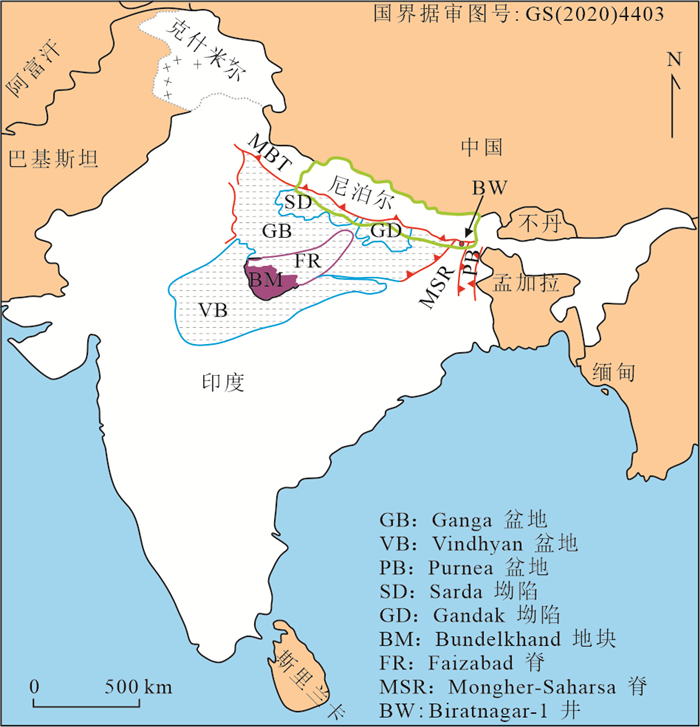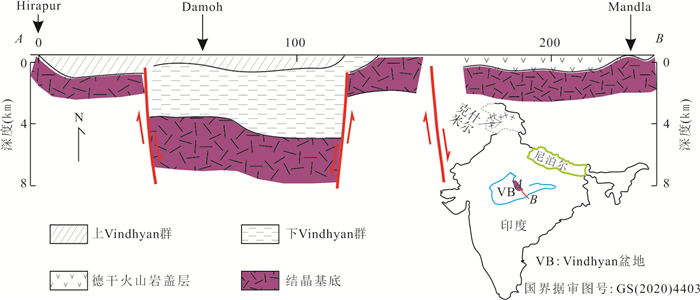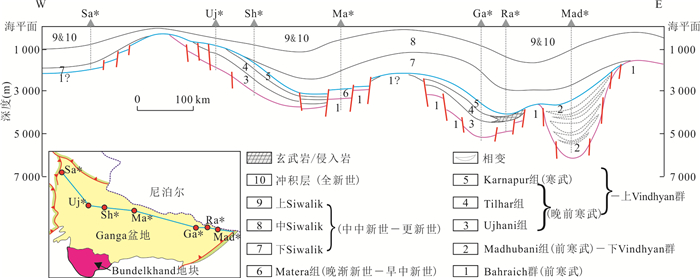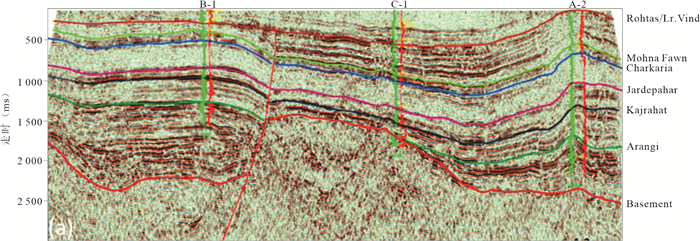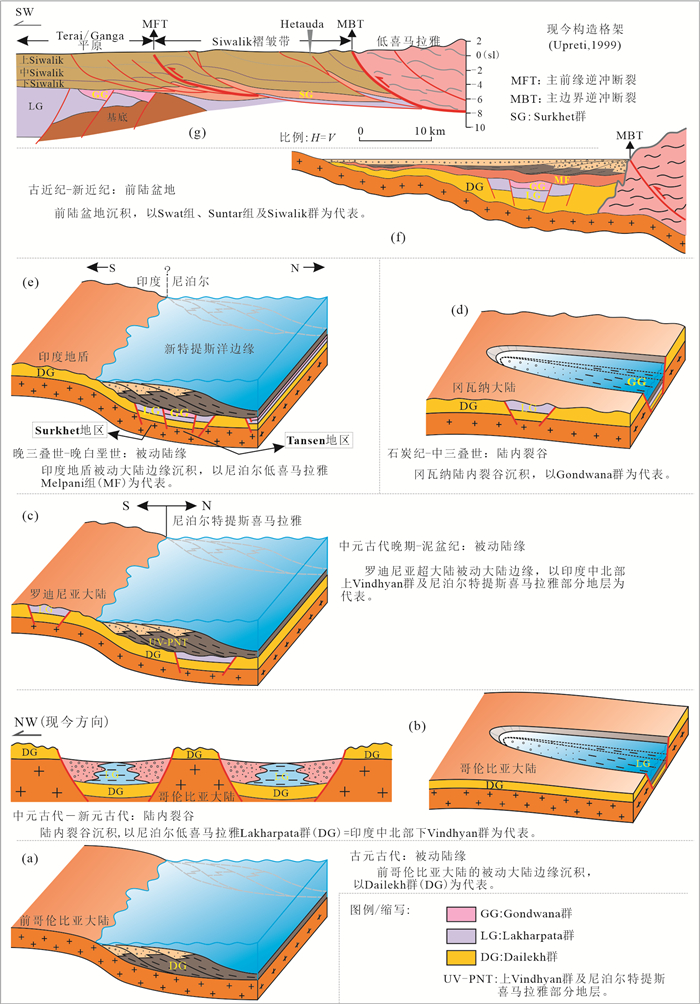The Tectonosedimentary Evolution since Proterozoic in Nepal and Its Southern Adjacent Areas
-
摘要: 迄今,尼泊尔及其南侧邻区元古宙以来的构造-沉积演化尚缺乏系统性研究.为了促进区域地质认识,结合前人研究成果及新的研究发现,对尼泊尔低喜马拉雅带及以南的构造-沉积演化首次进行系统性总结与讨论.结果表明:尼泊尔低喜马拉雅带及以南与印度地盾北缘在地质历史中的构造-沉积演化息息相关,且自元古宙以来,发育了被动大陆边缘→陆内裂谷→被动大陆边缘→前陆盆地等不同构造演化阶段的沉积响应;尼泊尔西部的Dailekh群属于~1.8 Ga以前或前哥伦比亚超大陆之前的被动大陆边缘沉积;Vindhyan超群为下断上坳的陆内裂谷沉积,尼泊尔境内的Lakharpata群相当于下Vindhyan群;Gondwana超大陆裂解导致由北往南形成一系列初始发育时间越来越晚的裂谷盆地;Surkhet群至Siwalik群为被动大陆边缘至前陆盆地沉积,其中,Surkhet群Swat/Subathu组是喜马拉雅南侧地质历史上最后一套海相沉积地层,也是被动大陆边缘向前陆盆地转换期的沉积响应;Siwalik群大规模的磨拉石建造标志着喜马拉雅快速和大幅度隆升,该群沉积成岩后,印度-欧亚板块进一步的挤压作用导致了地质历史上迄今为止最后一次强烈的构造运动,形成MFT与Siwalik褶皱带,并奠定了喜马拉雅带现今构造格局.Abstract: At present, the tectonosedimentary evolution since Proterozoic in Nepal and its southern adjacent area is still lacking of systematic research. In order to promote divisional geological understanding of the area, the author intends to combine the previous and the new research results to systematically summarize and discuss the tectonosedimentary evolution of the Lesser Himalaya of Nepal and its southern areas. The results show that, the tectonosedimentary evolution in the less Himalaya of Nepal and its southern areas are closely related to the northern part of the Indian shield in the geological history; since Proterozoic, it has experienced the following different stages of tectonic evolution in turn, that is from passive continental margin to intracontinental rift to passive continental margin to foreland basin; the Dailekh Group in western Nepal deposited in the passive continental margin before~1.8 Ga or before the pre-Columbia supercontinent; the Vindhyan supergroup deposited in an intracontinental rift(its lower part deposited in graben and its upper part deposited in depression), and the Lakharpata group in Nepal is equivalent to the lower Vindhyan group; the break-up of Gondwana supercontinent resulted in the formation of a series of rift basins with gradually late initial development time from north to south; the Surkhet Group and the Siwalik Group are deposited in passive continental margin to foreland basin, and the Swat/Subathu Formation of Surkhet Group is the last set of marine sedimentary strata in the geological history of the southern Himalayas, and it is also the key sedimentary response during the passive continental margin changing to the foreland basin; the large-scale molasse formation of the Siwalik Group marked the rapid and substantial uplift of the Himalayas, and after the group's sedimentation and diagenesis, the further compression of the Indo-Eurasian plate led to the last strong tectonic movement in geological history so far, forming the MFT and Siwalik fold belts, and forming the present tectonic framework of the Himalaya.
-
Key words:
- Himalaya /
- India shield /
- Nepal /
- tectonosedimentary evolution /
- break-up of continent /
- tectonics
-
图 1 研究区地质
a. 尼泊尔及邻区大地构造位置(据Dhital,2015);b. 尼泊尔地质简图(据Subedi et al.,2012);c. 南北向横跨尼泊尔地质构造剖面图(据Subedi et al.,2012)
Fig. 1. Geology of research area
图 3 Vindhyan盆地下断、上坳的剖面结构
据Prasad and Rao(2006)修改
Fig. 3. Structural section of the Vindhyan basin, with the characteristic of rifting in the lower part and depression in the upper part
图 5 恒河盆地东-西向钻井对比剖面所揭示的深部地堑、地垒格局
据Infraline Energy网站资料:http://www.infraline.com/ong/Upstream/NELP_VII/Ganga_Basin_NELP_VII.pdf
Fig. 5. The graben and horst patterns in the deep revealed by the east⁃west drilling cross⁃section in the Ganges Basin
图 6 Vindhyan盆地东南部Son Valley中下Vindhyan群沿断陷期正断层的构造反转(B⁃1井处)
先前断陷期的正断层后来轻微反转,呈现为低幅度的逆冲牵引背斜(Paul et al.,2013)
Fig. 6. Tectonic inversion (at Well B⁃1) of the normal faults in lower⁃middle Vindhyan Groups in the Son Valley of the southeastern part of the Vindhyan Basin
表 1 尼泊尔低喜马拉雅带及以南综合地层表
Table 1. Comprehensive stratigraphic table in the Lower Himalayas and the south of Nepal
地层单元 时代 厚度(m) 岩性特征 其他特征 大致沉积环境 构造背景 超群 群 组/段 Siwalik群 上Siwalik组 中中新世-早更新世 以巨厚的砾岩/磨拉石建造为主 前陆盆地 前陆盆地↑被动大陆边缘 中Siwalik组 2 400~6 300 以砂岩为主 下Siwalik组 1 100~2 800 红、紫、绿及杂色泥岩、粉砂岩及砂岩. 泥岩、粉砂岩比重较高 
Surkhet群
(Tansen群)Suntar组 晚白垩世-早中新世 ~750 硬的红褐色-绿灰色细-中粒砂岩与紫色、绿色及灰色页岩交互,且页岩中夹泥灰岩条带 与下伏地层呈角度不整合 河流 

Swat组 160~200 深灰-绿灰色页岩夹透镜状或条带状深灰色含化石灰岩 滨浅海-半深海 

Melpani组 > 280 浅灰-深灰色含铁变质石英岩及细-粗砂岩夹灰色炭质页岩及偶尔的砾岩及泥质灰岩夹层 
Gondwana群 Taltung组 晚石炭世-早白垩世 ~200 下部含底砾岩,之上为橄榄绿中粗砂岩与浅红-紫色夹少量不规则绿色斑点页岩交互. 底砾岩主要为火山岩及石英岩 该群在印度的地堑盆地含煤、产气,但在巴基斯坦的Potwar油田该群侏罗系产油. 该群在印度地盾为陆相沉积,并呈指状楔入东尼泊尔,但向东北至Arunachal山脚为海相沉积. 这海相沉积在中及东尼泊尔山前深部也可能发育 陆内裂谷 Sisne组 ~1 000 沉积岩及深灰-黑色页岩夹数层砂岩与砾岩;沉积岩成层性差,含花岗岩、基性岩、灰岩、白云岩及砂岩,粒径最大达15 cm,砂岩发育于中上部 
Midland超群 Lakharpata群(等同于印度的下Vindhyan群) Aru组 前寒武-早古生代 ? 白云岩为主,夹少量砂岩与页岩 相当于印度的下Vindhyan群,顶界为角度不整合. 厚度 > 5 000 m Katwa组 ? 灰-深橄榄灰-黑色钙质页岩,向上夹灰岩及黄灰-褐灰色灰质白云岩 Khara组 ? 灰岩与页岩相比重相当 Gawar组 ~1 700 下部以白云岩及灰岩为主、上部以页岩夹砂岩为主 Ramkot组 ~850 粉色、灰色砂岩及紫色、绿灰色-灰色页岩夹粉-灰色白云岩 Sangram组 ~1 700 灰-绿灰-黑色页岩为主,其次为钙质砂岩与灰岩 Dailekh群(等同于印度的Mahakoshal群) Nabhisthan组 前寒武 ? 千枚岩为主 变质沉积岩为主,夹变质侵入岩 被动大陆边缘 Dubidanda组 ? 中粗粒石英岩为主,夹变质侵入岩 Gitachaur组 ? 以云母片岩和云母石英岩为主 Parajul组 ? 中粒石英岩夹碳质片岩 Dailekh段 ? 以铁质胶结的中细粒石英岩为主 Dungeshworl组 ? 以片麻岩和花岗岩为主 Raniban组 ? 片岩、石英岩及片麻岩 Gorthi组 ? 片岩、石英岩 ++++++++++++++++ Dadeldhura群/基底++++++++++++++++ -
Banerjee, S., Dutta, S., Paikaray, S., et al., 2006. Stratigraphy, Sedimentology and Bulk Organic Geochemistry of Black Shales from the Proterozoic Vindhyan Supergroup (Central India). Journal of Earth System Science, 115(1): 37-47. https://doi.org/10.1007/BF02703024 Bera, M. K., Sarkar, A., Chakraborty, P. P., et al., 2008. Marine to Continental Transition in Himalayan Foreland. Geological Society of America Bulletin, 120(9/10): 1214-1232. https://doi.org/10.1130/B26265.1 Bhatia, S. B., Bhargava, O. N., 2006. Biochronological Continuity of the Paleogene Sediments of the Himalayan Foreland Basin: Paleontological and Other Evidences. Journal of Asian Earth Sciences, 26(5): 477-487. https://doi.org/10.1016/j.jseaes.2004.10.007 Bose, P. K., Sarkar, S., Chakrabarty, S., et al., 2001. Overview of the Meso-to Neoproterozoic Evolution of the Vindhyan Basin, Central India. Sedimentary Geology, 141: 395-419. https://doi.org/10.1016/S0037-0738(01)00084-7 Bouilhol, P., Jagoutz, O., Hanchar, J. M., et al., 2013. Dating the India-Eurasia Collision through Arc Magmatic Records. Earth and Planetary Science Letters, 366: 163-175. https://doi.org/10.1016/j.epsl.2013.01.023 Chakrabarti, B. K., 2016. Geology of The Himalayan Belt: Deformation, Metamorphism, Stratigraphy. Elsevier Science Publishing Co Inc, 264, Amsterdam. Chand, T., Sethi, S., Kaushal, S., et al., 2012. Source Organ of Acies in Tertiary and Pre-Tertiary Sequences of Ganga Basin and Their Hydrocarbon Exploration Significance. 9th Biennial International Conference & Exposition on Petroleum Geophysics: 7. Chenet, A., Quidelleur, X., Fluteau, F., et al., 2007. 40K-40Ar Dating of the Main Deccan Large Igneous Province: Further Evidence of KTB Age and Short Duration. Earth and Planetary Science Letters, 263(1-2): 1-15. https://doi.org/10.1016/j.epsl.2007.07.011 Decelles, P. G., Robinson, D. M., Quade, J., et al., 2001. Stratigraphy, Structure, and Tectonic Evolution of the Himalayan Fold-Thrust Belt in Western Nepal. Tectonics, 20(4): 487-509. https://doi.org/10.1029/2000TC001226 Dhital, M. R., 2015. Geology of the Nepal Himalaya. Springer International Publishing, 498. https://doi.org/10.1007/978-3-319-02496-7 Garzanti, E., 1999. Stratigraphy and Sedimentary History of the Nepal Tethys Himalaya Passive Margin. Journal of Asian Earth Sciences, 17(5): 805-827. https://doi.org/10.1016/S1367-9120(99)00017-6 Garzanti, E., Hu, X., 2015. Latest Cretaceous Himalayan Tectonics: Obduction, Collision or Deccan-Related Uplift? Gondwana Research, 28(1): 165-178. https://doi.org/10.1016/j.gr.2014.03.010 Gilleaudeau, G. J., Sahoo, S. K., Kah, L. C., et al., 2018. Proterozoic Carbonates of the Vindhyan Basin, India: Chemostratigraphy and Diagenesis. Gondwana Research, 57: 10-25. https://doi.org/10.1016/j.gr.2018.01.003 Gou, Z.B., Liu, H., Duan, Y.Y., et al., 2020. Timescales of Partial Melting in Yadong Region of Higher Himalayan Crystalline Sequence: Constraints from Zircon U-Pb Geochronology of Naiduila Migmatites. Earth Science, 45(8): 2894-2904(in Chinese with English abstract). Heaman, L. M., 1997. Global Mafic Magmatism at 2.45 Ga: Remnants of an Ancient Large Igneous Province? Geology, 25(4): 299-302. https://doi.org/10.1130/0091-7613(1997)025<0299:GMMAGR>2.3.CO;2 doi: 10.1130/0091-7613(1997)025<0299:GMMAGR>2.3.CO;2 Hodges, K. V., Hubbard, M. S., Silverberg, D. S., et al., 1988. Metamorphic Constraints on the Thermal Evolution of the Central Himalayan Orogen. Philosophical Transactions of the Royal Society B Biological Sciences, 326(A): 257-280. https://doi.org/10.1098/rsta.1988.0087 Kazi, T. N., Kumar, S.D., 2014. Petrography and Provenance of the Siwalik Group Sandstones from the Main Boundary Thrust Region, Samari River Area, Central Nepal, Sub-Himalaya. Boletin De Geologia, 36(2): 25-44. Khadka, D. R., 2017. Assessment of Hydrocarbon Prospectivity in Terai and Siwaliks, Exploration Block 2, Western Nepal. Joural of Geological Resource and Engineering, 5(3): 112-138. https://doi.org/10.17265/2328-2193/2017.03.003 Kumar, K., 1991. Anthracobune Aijiensis Bov. Sp. (Mammalia: Proboscidea) from the Subathu Formation, Eocene from NW Himalaya, India. Geobios, 24(2): 221-239. https://doi.org/10.1016/S0016-6995(91)80010-W Li, A., 2013. Structural Evolution of the Himalayan Thrust Belt, West Nepal. University of Houston, Houston. Li, J., Hu, X., Garzanti, E., et al., 2019. Late Cretaceous Topographic Doming Caused by Initial Upwelling of Deccan Magmas: Stratigraphic and Sedimentological Evidence. Geological Society of America Bulletin, 132(3-4) https://doi.org/10.1130/B35133.1 Li, J.H., Hou, G.T., Huang, X.N., et al., 2001. The Constraint for the Supercontinental Cycles: Evidence from Precambrian Geology of North China Block. Acta Petrologica Sinica, 17(2): 177-186(in Chinese with English abstract). Liu, X.B., Liu, X.H., Leloup, P. H., et al., 2012. Ductile Deformation within Upper Himalaya Crystalline Sequence and Geological Implications, in Nyalam Area, Southern Tibet. China Sci. Bull. , 57(17): 1562-1577(in Chinese with English abstract). doi: 10.1360/csb2012-57-17-1562 Macfarlane, A. M., 1993. Chronology of Tectonic Events in the Crystalline Core of the Himalaya, Langtang National Park, Central Nepal. Tectonics, 12(4): 1004-1025. https://doi.org/10.1029/93TC00916 Mahanti, S., Mukherjee, S., Mistry, T. K., et al., 2015. Mohana Fawn Limestone Gas Play: a New Discovery in Son Valley, Vindhyan Basin, India. 11th Biennial International Conference & Exposition, SPG India: 6. Manglik, A., Adilakshmi, L., Suresh, M., et al., 2015. Thick Sedimentary Sequence around Bahraich in the Northern Part of the Central Ganga Foreland Basin. Tectonophysics, 653: 33-40. https://doi.org/10.1016/j.tecto.2015.03.024 Meigs, A. J., Burbank, D. W., Beck, R. A., 1995. Middle-Late Miocene (>10 Ma) Formation of the Main Boundary Thrust in the Western Himalaya. Geology (Boulder), 23(5): 423-426. https://doi.org/10.1130/0091-7613(1995)023<0423:MLMMFO>2.3.CO;2 doi: 10.1130/0091-7613(1995)023<0423:MLMMFO>2.3.CO;2 Ojha, P. S., 2012. Precambrian Sedimentary Basins of India: An Appraisal of Their Petroleum Potential. Geological Society London Special Publications, 366(1): 19-58. https://doi.org/10.1144/SP366.11 Paul, S., Bisht, B. S., Raturi, V. C., et al., 2013. Exploring Frontiers through Sequence Stratigraphic Approach: Vindhyan Basin Case Study. 10th Biennial International Conference & Exposition, KOCHI: 7. Prasad, B. R., Rao, V. V., 2006. Deep Seismic Reflection Study over the Vindhyans of Rajasthan: Implications for Geophysical Setting of the Basin. Journal of Earth System Science, 115(1): 135-147. https://doi.org/10.1007/BF02703030 Prasad, B., Pundir, B. S., 2017. Gondwana Biostratigraphy of the Purnea Basin (Eastern Bihar, India), and Its Correlation with Rajmahal and Bengal Gondwana Basins. Journal of the Geological Society of India, 90(4): 405-427. https://doi.org/10.1007/s12594-017-0735-3 Ray, J. S., 2006. Age of the Vindhyan Supergroup: A Review of Recent Findings. Journal of Earth System Science, 115(1): 149-160. https://doi.org/10.1007/BF02703031 Raza, M., Khan, A., Shamim Khan, M., 2009. Origin of Late Palaeoproterozoic Great Vindhyan Basin of North Indian Shield: Geochemical Evidence from Mafic Volcanic Rocks. Journal of Asian Earth Sciences, 34(6): 716-730. https://doi.org/10.1016/j.jseaes.2008.10.011 Rogers, J. J. W., 1986. The Dharwar Craton and the Assembly of Peninsular India. Journal of Geology, 94: 129-143. doi: 10.1086/629019 Sahu, H. S., Raab, M. J., Kohn, B. P., et al., 2013. Denudation History of Eastern Indian Peninsula from Apatite Fission Track Analysis: Linking Possible Plume-Related Uplift and the Sedimentary Record. Tectonophysics, 608: 1413-1428. https://doi.org/10.1016/j.tecto.2013.06.002 Saunders, A. D., Jones, S. M., Morgan, L. A., et al., 2007. Regional Uplift Associated with Continental Large Igneous Provinces: the Roles of Mantle Plumes and the Lithosphere. Chemical Geology, 241(3-4): 282-318. https://doi.org/10.1016/j.chemgeo.2007.01.017 Sen, G., 2001. Generation of Deccan Trap Magmas. Journal of Earth System Science, 110(4): 409-431. https://doi.org/10.1007/BF02702904 Sharma, R. S., 2009. Cratons and Fold Belts of India. Springer, Switzerland, 304. Sheth, H. C., Mahoney, J. J., Chandrasekharam, D., 2004. Geochemical Stratigraphy of Deccan Flood Basalts of the Bijasan Ghat Section, Satpura Range, India. Journal of Asian Earth Sciences, 23(1): 127-139. https://doi.org/10.1016/S1367-9120(03)00116-0 Singh, B. P., Srivastava, A. K., 2011. Storm Activities During the Sedimentation of Late Paleocene-Middle Eocene Subathu Formation, Western Himalayan Foreland Basin. Journal of the Geological Society of India, 77(2): 130-136. https://doi.org/10.1007/s12594-011-0016-5 Srivastava, P., Patel, S., Singh, N., et al., 2013. Early Oligocene Paleosols of the Dagshai Formation, India: A Record of the Oldest Tropical Weathering in the Himalayan Foreland. Sedimentary Geology, 295(15): 142-156. https://doi.org/10.1016/j.sedgeo.2013.05.011 Stoecklin, J., 1980. Geology of Nepal and Its Regional Frame. Journal of the Geological Society, 137: 1-34. https://doi.org/10.1144/gsjgs.137.1.0001 Subedi, D. N., Mahato, S. P., Kc, S. B., et al., 2012. Oil and Gas Exploration Activities in Nepal. 22nd Geophysical Conference, ASEG: 1-4. . https://doi.org/10.1071/ASEG2012ab050 Tripathy, G. R., Singh, S. K., 2015. Re-Os Depositional Age for Black Shales from the Kaimur Group, Upper Vindhyan, India. Chemical Geology, 413: 63-72. https://doi.org/10.1016/j.chemgeo.2015.08.011 Upreti, B. N., 1999. An Overview of the Stratigraphy and Tectonics of the Nepal Himalaya. Journal of Asian Earth Sciences, 17(5): 577-606. https://doi.org/10.1016/S1367-9120(99)00047-4 Wang, W., Cawood, P. A., Pandit, M. K., et al., 2020. Fragmentation of South China from Greater India During the Rodinia-Gondwana Transition. Geology, 49: 228-232. https://doi.org/10.1130/G48308.1 Yin, A., 2006. Cenozoic Tectonic Evolution of the Himalayan Orogen as Constrained by Along-Strike Variation of Structural Geometry, Exhumation History, and Foreland Sedimentation. Earth Science Frontiers, 13(5): 416-515(in Chinese with English abstract). Zhang, Z.M., Ding, H.X., Dong, X., et al, 2019. Two Contrasting Eclogite Types in the Himalayan Orogen and Differential Subduction of Indian Continent. Earth Science, 44(5): 1602-1619(in Chinese with English abstract). Zhao, G., Sun, M., Wilde, S. A., et al., 2004. A Paleo-Mesoproterozoic Supercontinent: Assembly, Growth and Breakup. Earth-Science Reviews, 67(1-2): 91-123. https://doi.org/10.1016/j.earscirev.2004.02.003 苟正彬, 刘函, 段瑶瑶, 等, 2020. 亚东地区高喜马拉雅结晶岩系部分熔融的时限: 来自乃堆拉混合岩锆石U-Pb年代学的约束. 地球科学, 45(8): 2894-2904. https://www.cnki.com.cn/Article/CJFDTOTAL-DQKX202008011.htm 李江海, 侯贵廷, 黄雄南, 等, 2001. 华北克拉通对前寒武纪超大陆旋回的基本制约. 岩石学报, 17(2): 177-186. https://www.cnki.com.cn/Article/CJFDTOTAL-YSXB200102000.htm 刘小兵, 刘小汉, Leloup P.H., 等, 2012. 藏南聂拉木高喜马拉雅结晶岩系上部韧性变形年代学及地质意义. 科学通报, (17): 1562-1574. https://www.cnki.com.cn/Article/CJFDTOTAL-KXTB201217007.htm 尹安, 2006. 喜马拉雅造山带新生代构造演化: 沿走向变化的构造几何形态、剥露历史和前陆沉积的约束. 地学前缘, 13(5): 416-515. doi: 10.3321/j.issn:1005-2321.2006.05.017 张泽明, 丁慧霞, 董昕, 等, 2019. 喜马拉雅造山带两种不同类型榴辉岩与印度大陆差异性俯冲. 地球科学, 44(5): 1602-1619. https://www.cnki.com.cn/Article/CJFDTOTAL-DQKX201905016.htm -









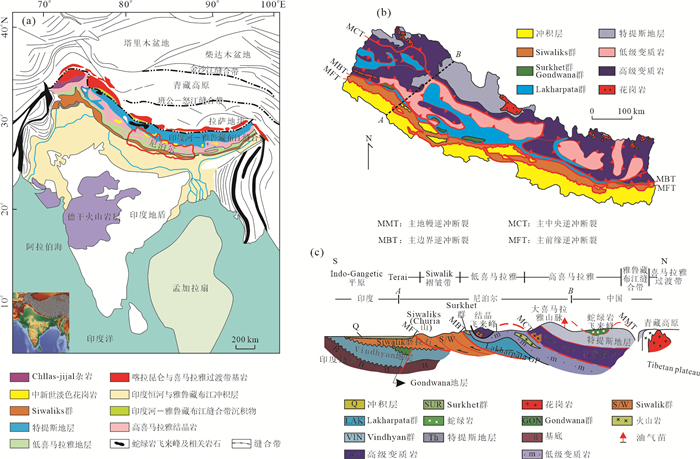
 下载:
下载:
